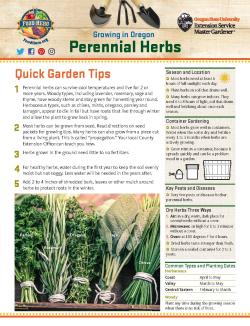Quick Garden Tips
- Perennial herbs can survive cool temperatures and live for 2 or more years. Woody types, including lavender, rosemary, sage and thyme, have woody stems and stay green for harvesting year round. Herbaceous types, such as chives, mints, oregano, parsley and tarragon, appear to die in fall but have roots that live through winter and allow the plant to grow back in spring.
- Most herbs can be grown from seed. Read directions on seed packets for growing tips. Many herbs can also grow from a piece cut from a living plant. This is called “propagation.” Your local County Extension Office can teach you how.
- For healthy herbs, water during the first year to keep the soil evenly moist but not soggy. Less water will be needed in the years after.
- Add 2 to 4 inches of shredded bark, leaves or other mulch around herbs to protect roots in the winter.
Season and Location
- Most herbs need at least 6 hours of full sunlight each day.
- Plant herbs in soil that drains well.
- Many herbs can grow indoors. They need 6 to 8 hours of light, soil that drains well and fertilizing about once each season.
Container Gardening
- Most herbs grow well in containers. Water when the soil is dry and fertilize every 1 to 3 months when herbs are actively growing.
- Grow mint in a container, because it spreads quickly and can be a problem weed in a garden.
Key Pests and Diseases
- Very few pests or diseases bother perennial herbs.
Dry Herbs Three Ways
- Air: in a dry, warm, dark place for several weeks without a cover.
- Microwave: on high for 1 to 3 minutes without a cover
- Oven: at 180 degrees F for 4 hours.
Common Types and Planting Dates
Herbaceous
- Coast: April to May
- Valley: March to May
- Central/Eastern: February to March
Woody
- Plant any time during the growing season when there is no risk of frost.
Recommended Types to Grow
- Most herbs are easy to grow in Oregon. Plant types that are ingredients in the recipes you like to make.
When and How to Harvest
- You can harvest herbs as soon as the plant has enough leaves to keep growing after you've picked. Younger leaves will have the most flavor.
- Harvest during a cool part of the day using scissors or clippers. Snip just below a pair of leaves, leaving 4 to 6 inches of stem for new growth. Do not harvest more than one-third of the plant at one time.
- Leaves and flower stalks of chives can be cut just above the soil. The puffy flowers can be eaten; they have a mild onion flavor.
Storage and Cooking
- Refrigerate fresh herbs in a glass of water like flowers. Cover with a loose plastic bag for up to a week.
- Rinse herbs just before using. Push them up and down in a bowl of water, lift out of the water and repeat in more fresh water until no dirt appears in the bowl.
- Make ice with herbs frozen into it.
- Use herbs to flavor soups and stews, salads, pastas, dips, sauces and pizzas.
- Try this Food Hero recipe: Herb Flavored Water



